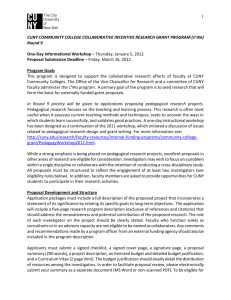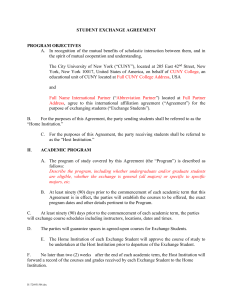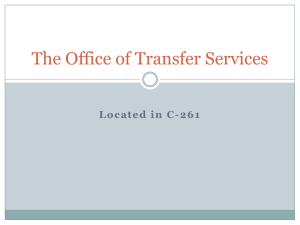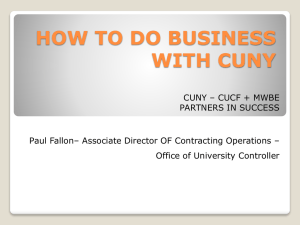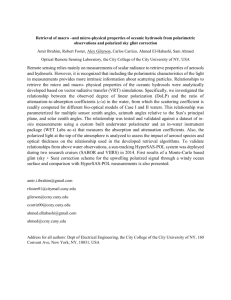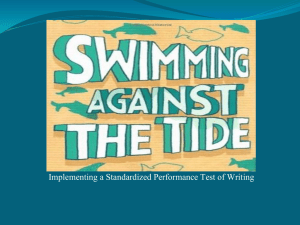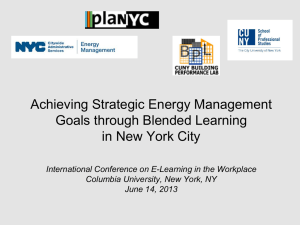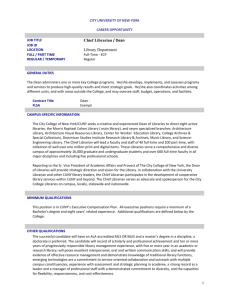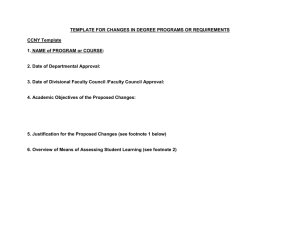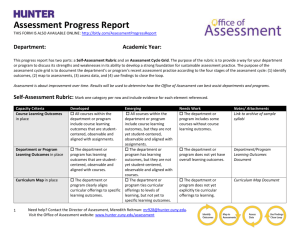CUNY Center for Advanced Technology (CUNYCAT)
advertisement
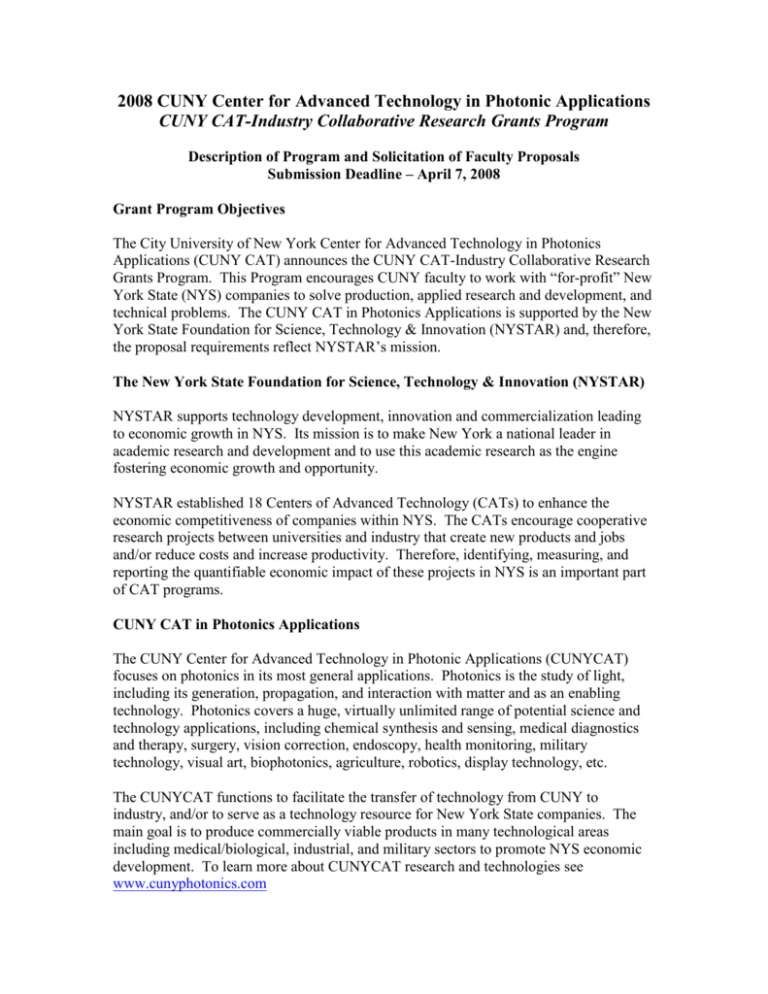
2008 CUNY Center for Advanced Technology in Photonic Applications CUNY CAT-Industry Collaborative Research Grants Program Description of Program and Solicitation of Faculty Proposals Submission Deadline – April 7, 2008 Grant Program Objectives The City University of New York Center for Advanced Technology in Photonics Applications (CUNY CAT) announces the CUNY CAT-Industry Collaborative Research Grants Program. This Program encourages CUNY faculty to work with “for-profit” New York State (NYS) companies to solve production, applied research and development, and technical problems. The CUNY CAT in Photonics Applications is supported by the New York State Foundation for Science, Technology & Innovation (NYSTAR) and, therefore, the proposal requirements reflect NYSTAR’s mission. The New York State Foundation for Science, Technology & Innovation (NYSTAR) NYSTAR supports technology development, innovation and commercialization leading to economic growth in NYS. Its mission is to make New York a national leader in academic research and development and to use this academic research as the engine fostering economic growth and opportunity. NYSTAR established 18 Centers of Advanced Technology (CATs) to enhance the economic competitiveness of companies within NYS. The CATs encourage cooperative research projects between universities and industry that create new products and jobs and/or reduce costs and increase productivity. Therefore, identifying, measuring, and reporting the quantifiable economic impact of these projects in NYS is an important part of CAT programs. CUNY CAT in Photonics Applications The CUNY Center for Advanced Technology in Photonic Applications (CUNYCAT) focuses on photonics in its most general applications. Photonics is the study of light, including its generation, propagation, and interaction with matter and as an enabling technology. Photonics covers a huge, virtually unlimited range of potential science and technology applications, including chemical synthesis and sensing, medical diagnostics and therapy, surgery, vision correction, endoscopy, health monitoring, military technology, visual art, biophotonics, agriculture, robotics, display technology, etc. The CUNYCAT functions to facilitate the transfer of technology from CUNY to industry, and/or to serve as a technology resource for New York State companies. The main goal is to produce commercially viable products in many technological areas including medical/biological, industrial, and military sectors to promote NYS economic development. To learn more about CUNYCAT research and technologies see www.cunyphotonics.com Research Proposals Requested The CUNYCAT seeks to enhance and broaden participation of CUNY faculty researchers in research projects with small and large NYS companies by requesting proposals for collaborative research with NYS companies where photonics is the enabling technology. All proposals must detail the collaboration they involve with a “for-profit” NYS company Research Collaboration with Industry For faculties that have worked with “for-profit companies,” this grant program may provide an opportunity to expand those collaborations or work with additional companies. Many CUNY faculty have never conducted research with “for-profit companies” and may need help with the following: Identifying Appropriate Companies. Some researchers may be conducting research or using techniques which may benefit commercial companies, but have not identified an industry or NYS company that could benefit from their expertise. Project Development: A project that meets both the university and company needs often requires multiple discussions to articulate specific deliverables. Structuring and Negotiating Agreements with Companies; Research agreements with “for-profit” companies involve business and intellectual property issues different from government and state agencies. Assessing Economic Impact: Academic researchers as well as “for-profit” companies are rarely asked for quantitative data documenting the extent and consequences of their research collaborations on the region’s economy such as jobs created or revenues generated. The CUNY CAT is prepared to assist CUNY researchers interested in any or all of the above Call Mr. Alan Doctor, the CAT’s Director of Business Development at 718-997-4279 to discuss your eligibility, potential industry sponsor and project plans. (An RFP FAQ page will appear on the CAT website) Matching Funds The CAT is a cost sharing program where cash from a New York State “for-profit” company is matched with funding from the CAT. The required matching funds for companies are one dollar of company funds for one dollar of NYSTAR funds. Additionally, the overhead rate on CAT projects is limited to 15% of personnel costs (The standard CUNY rate is ~ 55% of total direct costs). In all instances, funding is subject to the availability of funds and budgetary approvals. Eligible Use of Funds Grant funds may be used to hire research associates or assistants, purchase faculty release time at adjunct rates, or for items other than personnel services. Faculty summer salary is permitted. All investigators can request summer salary will be granted for one year only; the cumulative maximum is $5,000 per year for all investigators on a grant award. There is no limit on the amount of funds requested provided the company sponsors half of the total project costs. Proposal Evaluation A committee of qualified individuals serving at the invitation of the CUNY CAT Director will initially screen the proposals for eligibility. Proposals which fail to meet the RFP requirements will be returned to the submitter with a statement as to why it fails to meet the RFP. The Committee will then evaluate the proposals on their technical merit, collaboration with a “for profit” NYS Company, and their potential economic impact on NYS economy according to the following scoring criteria: a. Scientific and technical integrity (50 points) b. Potential economic impact on the State of New York (50 points) Scientific and technical integrity: Clearly describe the problem, objectives, methodology with alternatives. Specific emphasis will be placed on the deliverables. The importance of engineering and development as well as research will be treated equally in the ranking. Economic impact: Ranking will be strongly dependent on the potential jobs and revenues caused by the proposed projects. Economic impact is weighed equally with scientific and technical integrity; Researchers are expected to collaborate with their industrial partner(s) in preparing the Economic Impact portion of their proposals. CUNYCAT personnel may directly contact designated company contacts in order to enhance Economic Impacts. Eligibility All full time faculty at the CUNY campuses are eligible to apply. Proposals may be submitted by a single investigator or a team of investigators. Multiple proposals from a single investigator or a team of investigators are eligible provided each involves collaboration with a separate company. Specific Proposal Guidelines Complete proposals must be submitted electronically via email ONLY (with the original signed Proposal Checklist and Signature Page submitted by mail) 1) Completed Cover page. 2) Signature Page. Original (submitted by mail) includes College Grant Officers and Campus Endorsement signatures, as required. 3) Proposal Summary of 200 words or less 4) Project Description: Narrative description of the project. No more than five pages single-spaced, exclusive of references and citations, with one-inch borders and 12-point type. The role of the sponsoring company and the CUNY investigator(s) should be clearly stated as well as plans for transferring results to the company sponsor, project deliverables, and timetable. 5) Explanation (on a separate sheet and no more than one single spaced page) of how the project will benefit the participating company and region’s economic development. Include remarks on the potential for sustaining the interaction beyond the funding period, and a statement of the investigators' commitment to bring any products developed as result of this project to market. 6) Proposed Budget for the 12-month funding period. 7) Budget Explanation. The budget explanation page should clearly indicate the distribution of resources among the investigators. It should also include an academic year percentage of effort by each participating faculty member. 8) Brief biographical information from each participating faculty member. The total length should not exceed two pages for each faculty member. A proposal checklist is included for your convenience. Approvals, Submission and Timetable The proposal must be approved and signed on the cover sheet by the Grants Officer and the Campus Endorsement official (to approve requested release time) of each participating campus and follow normal campus procedures for proposal approval at those campuses. The complete electronic copy should be submitted by email to University Dean for Research Gillian Small c/o Dr. Stella Manne at oaaresearch@mail.cuny.edu. Proposal emails must be time stamped no later than 5:00 PM on April 7th, 2008. Proposals should be mailed to: University Dean for Research Gillian Small c/o Dr. Stella Manne The City University of New York Office of Academic Affairs 535 East 80th Street, 6th floor New York, NY 10075
